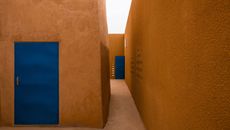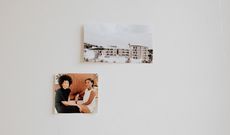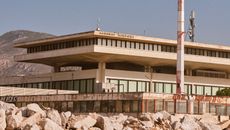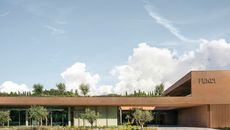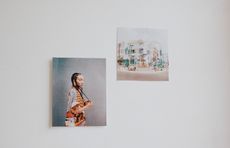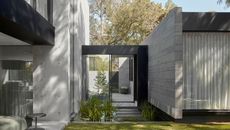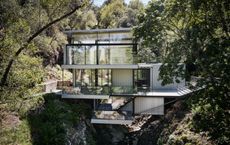IQON is BIG’s South American debut in Quito
Quito gets a brutalist urban addition – IQON – courtesy of Bjarke Ingels and Ecuadorian developer Uribe Schwarzkopf
- (opens in new tab)
- (opens in new tab)
- (opens in new tab)
- Sign up to our newsletter Newsletter

With IQON, the vertiginous growth of Quito’s built skyline has reached a new milestone. The project marks the completion of the first of a pair of towers in the city by Bjarke Ingels’ architecture studio BIG, that looms over La Carolina, the Ecuadorian capital’s version of Central Park. At some 131m high, the 33-storey brutalist centrepiece becomes Quito’s tallest building, surpassing the Basílica del Sagrado Voto Nacional, a Roman Catholic cathedral in Quito’s historic centre.

IQON by BIG
Quito’s upwardly mobile transformation has been made possible by the relaxation of height limits, which moved from 15 to 40 storeys following the relocation of the international airport outside the city’s boundaries in 2015. Things – and the city’s inhabitants – have been looking up ever since.
IQON’s developer, Uribe Schwarzkopf, has been leading the boom in contemporary skyscrapers with its self-styled version of 'healthy urbanism', enrolling help from global architects like BIG, Moshe Safdie, Carlos Zapata, Jean Nouvel, Arquitectonica and MAD to reshape the city’s skyline.

Designed to occupy an L-shaped site, BIG’s distinctive high-rise curves around the plot from north to south creating 220 luxury apartments. They tower over the city looking out at differing angles to the north or west, while its more traditional east-facing flank has been given up to trendy offices.
BIG’s rotating volume repeats itself every three floors, giving the façade a prickly, ‘pineapple’ appearance. The jagged exoskeleton pattern crafted from concrete blocks that stack on top of one another, produces myriad corners, crooks and crevices that have been converted into balconies and terraces for each apartment.

To soften the building’s brutalist, concrete shell, the architecture studio introduced what it calls an ‘urban tree farm’, planting a selection of mid-sized trees and shrubs from Ecuador’s rich biodiversity in planters occupying corners of the neighbouring apartments below. Trees will be replanted in the park when they outgrow the structure, says the architect.
The tower is something of an architectural anomaly, according to Lorenz Krisai, design lead for BIG on both IQON and the follow-up project to the south of the park, EPIQ. The materials and complex finish would be almost impossible to pull off in any other climate or for another client, he says.

'A brutalist building like this probably wouldn’t have been possible anywhere else or with any other partner. No matter how much we kept pushing the concept to its limits they kept saying, “yes”,' he says.
Completed in October 2022, IQON’s striking façade has already converted the building into a photogenic addition to Quito’s impressive existing body of brutalist architecture – it includes notable examples, such as the Templo de la Patria by local architect, Milton Barragán.

Inside IQON, apart from the office and residential offering, the developer gave over three floors to playful communal facilities, including a bowling alley, an arcade and a music room for jamming on the sixth floor, as well as a poker room and a squash court by the Olympic-sized pool on the rooftop.


uribeschwarzkopf.com (opens in new tab)
big.dk (opens in new tab)
Originally hailing from the UK, Rainbow Blue Nelson first landed in Colombia in search of Tintinesque adventures in 1996. Subsequent forays from his Caribbean base in Cartagena have thrown up a book about Pablo Escobar, and the Wallpaper* City Guides for Santiago, Brasilia, Bogota and Miami. Currently completing a second book about Colombia whilst re-wilding 50 hectares of tropical rainforest on the country's Caribbean coast, he’s interviewed some of South America's most influential figures in art, design and architecture for Wallpaper* and other international publications.
-
 Men’s engagement rings for modern grooms
Men’s engagement rings for modern groomsMen’s engagement rings, whether classic or colourful, make for sentimental tokens
By Hannah Silver • Published
-
 Longchamp unites with D’heygere on a playful collection made to ‘transform the everyday’
Longchamp unites with D’heygere on a playful collection made to ‘transform the everyday’Inspired by Longchamp’s foldaway ‘Le Pliage’ bag, this collaboration with Paris-based jewellery and accessories designer Stéphanie D’heygere sees pieces that ‘transform and adapt’ to their wearer
By Jack Moss • Published
-
 Last chance to see: Marc Newson’s all-blue designs in Athens
Last chance to see: Marc Newson’s all-blue designs in AthensGagosian gallery Athens presents new blue furniture and objects by Marc Newson
By Rosa Bertoli • Published
-
 Niger’s Atelier Masōmī designs to ‘elevate, dignify and provide a better quality of life’
Niger’s Atelier Masōmī designs to ‘elevate, dignify and provide a better quality of life’Atelier Masōmī from Niger is part of our series of profiles of architects, spatial designers and builders shaping West Africa's architectural future
By Ellie Stathaki • Published
-
 Atelier Inhyah on sustainable ecosystems, craft, and a local approach
Atelier Inhyah on sustainable ecosystems, craft, and a local approachAtelier Inhyah from Ivory Coast is part of our series of profiles of architects, spatial designers and builders shaping West Africa's architectural future
By Aude Tollo • Published
-
 Athens in 2023: architecture and creativity are on the up
Athens in 2023: architecture and creativity are on the upAthens is enjoying its very own metamorphosis with a plethora of recently restored buildings, large-scale projects and fresh new openings
By Ellie Stathaki • Published
-
 The Fendi factory in Tuscany disappears into the landscape
The Fendi factory in Tuscany disappears into the landscapeThe new Fendi Factory in Italy, set in the rolling hills of Tuscany, is the brainchild of Milan architecture studio Piuarch and the luxury brand
By Ellie Stathaki • Published
-
 Senegal’s Mamy Tall on city planning, bioclimatic construction and heritage
Senegal’s Mamy Tall on city planning, bioclimatic construction and heritageMamy Tall from Senegal is part of our series of profiles of architects, spatial designers and builders shaping West Africa's architectural future
By Ellie Stathaki • Published
-
 Park House is a minimalist, art-filled family home in Melbourne
Park House is a minimalist, art-filled family home in MelbournePark House by Mim Design and Pleysier Perkins is an art-filled family home in Melbourne including a bold, concrete extension
By Nick Compton • Published
-
 Year in review: top 10 houses of 2022, selected by Wallpaper* architecture editor Ellie Stathaki
Year in review: top 10 houses of 2022, selected by Wallpaper* architecture editor Ellie StathakiWallpaper’s Ellie Stathaki reveals her top 10 houses of 2022 – from modernist reinventions to urban extensions and idyllic retreats
By Ellie Stathaki • Published
-
 This bijou Sonoma County house is in sync with the landscape
This bijou Sonoma County house is in sync with the landscapeAn open and contextual Sonoma County house, Leit House is designed by San Francisco’s Schwartz and Architecture
By Ellie Stathaki • Published



